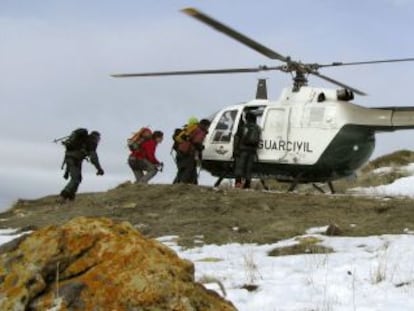Aconcagua climbers will have to pay for their own helicopter rescue
Provincial authorities in Mendoza say cost of providing $2,500-an-hour service is too high


The tough ascent up the 6,962 meters to the top of Aconcagua – the “roof of the Americas,” and the highest peak in the world outside of the Himalayas – has just become a little harder after the introduction of a new obstacle.
From now on, climbers who have an accident or lose their way on the Andean mountain will have to pay for their own air rescue, to the tune of around 40,000 pesos ($2,500) an hour for the helicopter ride.
The new system went into effect on November 15, according to an announcement by the government of Mendoza province in Argentina, where the popular peak is located.
We are of the opinion that helicopter flight hours should be reduced, but not in this way
José Casas, tourism entrepreneur
The only exception to the rule will be when a medic orders an air rescue for a mountaineer affected by altitude sickness or some other life-threatening condition during the course of the climb.
All other climbers requiring assistance will pay for the chopper and for the personnel required to provide them with assistance.
Until now, helicopter rescues had been financed by the provincial government of Mendoza, where Aconcagua is one of the main tourist draws. But the conservative coalition that took over in December has changed the rules.
“Last year, when we took office, the season was already upon us. A total of 230 flight hours had been contracted out, equivalent to around 10 million pesos [$650,000] from our budget,” said a spokesperson for the regional environment department.
New officials feel that there has been “a waste” of resources in recent years
New officials feel that there has been “a waste” of resources in recent years, and criticized the fact that choppers were used to transport food and water, and to conduct non-urgent evacuations that could have been done through other means.
But the department spokesperson also added that climbers will be charged by the minute, not the hour, and that the average airlift takes no more than 10 minutes.
In any case, the decision will not come as good news to people who provide services to climbers in this popular spot, where the season extends through to March 15.
“We believe that helicopter flight hours should be reduced, but not in this way. These days [the service] lives off what climbers are being charged; in fact, rates already went up four years ago over this issue,” said José Casas, a tourism entrepreneur, in statements to the local daily Los Andes.
Casas noted that climbers already pay a $100 insurance fee to go up the Aconcagua, and that these revenues are more than enough to cover the cost of air rescues.
“Since the permit is paid in dollars, with the devaluation and the end of the parallel dollar, the state ended up making a lot more money,” he said.
Helicopters are only one of the ways in which climbers in trouble can be rescued, and weather conditions in this wind-blown mountain range where lack of oxygen makes high-altitude rescues impossible.
Last year, more than 5,000 people visited Aconcagua National Park. Of these, nearly a third attempted to summit.
English version by Susana Urra.
Tu suscripción se está usando en otro dispositivo
¿Quieres añadir otro usuario a tu suscripción?
Si continúas leyendo en este dispositivo, no se podrá leer en el otro.
FlechaTu suscripción se está usando en otro dispositivo y solo puedes acceder a EL PAÍS desde un dispositivo a la vez.
Si quieres compartir tu cuenta, cambia tu suscripción a la modalidad Premium, así podrás añadir otro usuario. Cada uno accederá con su propia cuenta de email, lo que os permitirá personalizar vuestra experiencia en EL PAÍS.
¿Tienes una suscripción de empresa? Accede aquí para contratar más cuentas.
En el caso de no saber quién está usando tu cuenta, te recomendamos cambiar tu contraseña aquí.
Si decides continuar compartiendo tu cuenta, este mensaje se mostrará en tu dispositivo y en el de la otra persona que está usando tu cuenta de forma indefinida, afectando a tu experiencia de lectura. Puedes consultar aquí los términos y condiciones de la suscripción digital.
More information
Últimas noticias
Most viewed
- Why we lost the habit of sleeping in two segments and how that changed our sense of time
- Charles Dubouloz, mountaineering star, retires at 36 with a farewell tour inspired by Walter Bonatti
- Venezuela faces its most tense Christmas yet
- CBS in crisis after pulling a report on Trump’s deportations to El Salvador (which later leaked online)
- Bukele clan fumes over investigation exposing their new wealth










































